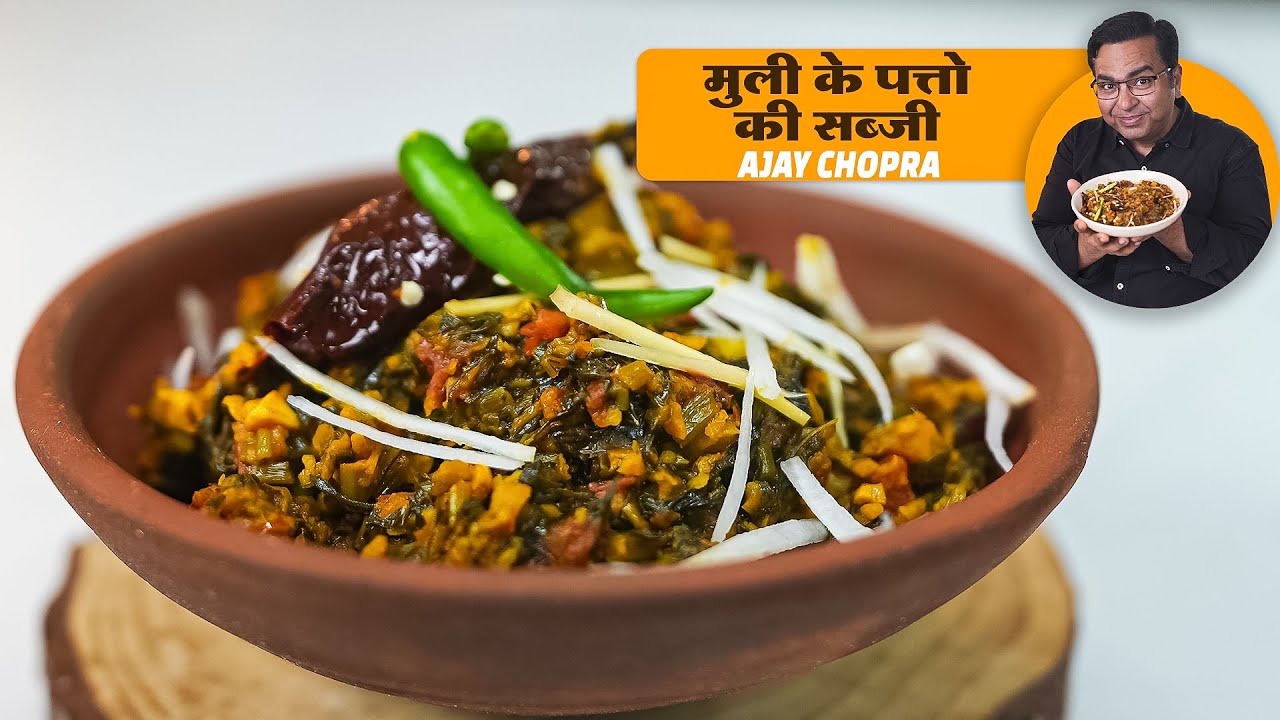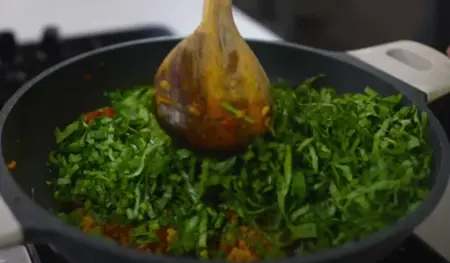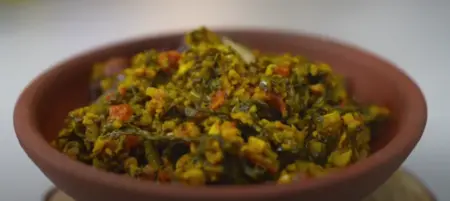
Mooli ke Patte ki Sabzi Recipe

30 Mins

3-4 People

05 Mins
Introduction
The crisp, peppery flavor of Mooli ke Patte ki Sabzi takes me back to my childhood days spent in my grandmother's kitchen. I remember watching in awe as she skillfully prepared this delectable dish, using fresh radish leaves plucked straight from her garden. The aroma of garlic and cumin seeds sizzling in hot mustard oil filled the air, signaling that something truly special was about to be cooked. As I took my first bite, I was instantly transported to a world of flavor, where the earthiness of the radish leaves mingled with the spices in perfect harmony. Since then, Mooli ke Patte ki Sabzi has held a special place in my heart, reminding me of the simple joys of home-cooked meals and cherished family recipes.
Ingredients:
-
For Moong Dal:
- ½ cup soaked Moong Dal
- Water (as required)
- ½ tsp Turmeric Powder
-
For Sabji:
- 1 bundle Radish with leaves
- 2 tbsp Mustard Oil
- ½ tsp Jeera (Cumin Seeds)
- 2 pieces Dry Red Chilli
- 1 tbsp Garlic (finely chopped)
- 1 tbsp Green Chilli (finely chopped)
- ½ tbsp Ginger (chopped)
- ½ cup Tomato (chopped)
- ½ tsp Salt
- ½ tsp Turmeric Powder
- 1 tsp Red Chilli Powder
- ½ tsp Sabzi Masala (Vegetable Spice Mix)
Instructions:
Step 1: Prepare the Radish Leaves and Moong Dal
Wash and clean the radish leaves thoroughly. Once dry, shred them. Also, chop the radish and set it aside.
Blanch the Moong Dal by heating water in a pan. Add salt and turmeric powder. Soak the yellow moong dal and blanch it in the water for 1-2 minutes. Strain the moong dal and set it aside.
Step 2: Begin Cooking the Sabzi
Heat mustard oil in a pan until it's hot. Add jeera and dry red chilli, letting them splutter in the oil. Add the finely chopped garlic and sauté until fragrant.
Step 3: Add Aromatics
Add chopped green chilli and ginger to the pan. Continue sautéing until well combined and aromatic.
Step 4: Cook the Tomatoes
Add the chopped tomatoes to the pan and sauté until they soften, forming a flavorful base.
Step 5: Season the Sabzi
Season the mixture with salt, turmeric powder, red chilli powder, and sabzi masala. Allow the spices to cook and meld with the other ingredients.
Step 6: Add Moong Dal and Radish
Add the blanched moong dal and chopped radish to the pan. Mix thoroughly, ensuring an even distribution of flavors.

Step 7: Cook the Radish Leaves
Introduce the shredded radish leaves and continue stirring. Cook the mixture on high flame for 1-2 minutes, then reduce the heat to medium-low. Cover the pan with a lid and let the dish cook for an additional 5-6 minutes, stirring occasionally.
Step 8: Serve the Sabzi
Your Mooli ke Patte ki Sabzi is now ready to be served. This dish combines the nutritional benefits of radish leaves and moong dal with aromatic spices, making it a delightful addition to any meal with roti or rice. Enjoy!

About the Recipe
Mooli ke Patte ki Sabzi, or radish leaf curry, is a traditional Indian dish made from the leaves of the radish plant. Often overlooked, radish leaves are packed with nutrients and flavor, making them a wonderful addition to any meal. In this recipe, the radish leaves are washed thoroughly and then cooked with onions, garlic, tomatoes, and a blend of aromatic spices. The result is a fragrant and flavorful curry that pairs perfectly with steamed rice or roti. Mooli ke Patte ki Sabzi is not only delicious but also a great way to reduce food waste by utilizing all parts of the radish plant.
Cooking Tips
- Cleaning Radish Leaves: Ensure that the radish leaves are thoroughly washed to remove any dirt or grit before cooking.
- Trimming: Trim the tough stems from the radish leaves before chopping them to enhance the texture of the dish.
- Balancing Flavors: Adjust the amount of spices and seasoning according to your taste preferences to achieve the perfect balance of flavors.
- Cooking Time: Be mindful not to overcook the radish leaves, as they can become mushy. Cook them until they are just wilted and tender.
- Freshness: Use fresh radish leaves for the best flavor and texture in the dish.
- Tempering: The tempering of mustard seeds, cumin seeds, and garlic in hot oil adds a depth of flavor to the curry. Ensure that the oil is hot enough before adding the tempering ingredients.
- Variations: Experiment with different spices and ingredients such as green chilies, ginger, or coconut to customize the flavor of the dish according to your liking.
Pairing Guide
- Steamed Rice: Serve Mooli ke Patte ki Sabzi with hot steamed rice for a comforting and satisfying meal.
- Roti: Enjoy the curry with freshly made roti or paratha for a wholesome and nutritious meal.
- Yogurt: Pair the spicy radish leaf curry with cool and creamy yogurt to balance out the flavors.
- Pickles: Accompany the sabzi with tangy mango or lime pickles for an extra burst of flavor.
Frequently Asked Questions about Mooli ke Patte ki Sabzi
- Can I use radish greens from store-bought radishes to make this dish?
- Yes, you can use radish greens from store-bought radishes to make Mooli ke Patte ki Sabzi.
- Are radish leaves nutritious?
- Yes, radish leaves are rich in vitamins, minerals, and antioxidants, making them highly nutritious.
- How do I store radish leaves before cooking?
- Store radish leaves in the refrigerator wrapped in a damp paper towel or cloth to keep them fresh for longer.
- Can I freeze Mooli ke Patte ki Sabzi for later use?
- Yes, you can freeze the curry in an airtight container for up to 2-3 months. Thaw it in the refrigerator before reheating.
- Can I make this dish vegan?
- Yes, you can make Mooli ke Patte ki Sabzi vegan by skipping the addition of ghee or substituting it with oil.
- What other vegetables can I add to this curry?
- You can add vegetables like potatoes, peas, or carrots to enhance the flavor and nutrition of the dish.
- Is this dish spicy?
- The spiciness of the dish can be adjusted according to your preference by varying the amount of green chilies or red chili powder used.
- Can I use dried radish leaves to make this curry?
- While fresh radish leaves are preferred for this recipe, you can use dried radish leaves if fresh ones are not available.
- Can I make this dish ahead of time?
- Yes, you can prepare the curry ahead of time and reheat it before serving. Adjust the consistency with a little water if needed.
- What is the origin of Mooli ke Patte ki Sabzi?
- Mooli ke Patte ki Sabzi is a traditional Indian dish that has been enjoyed for generations, especially in regions where radishes are commonly grown.
